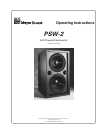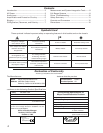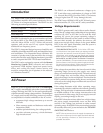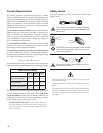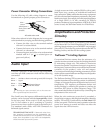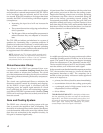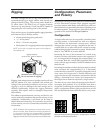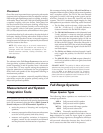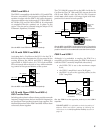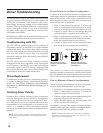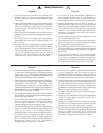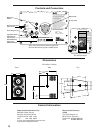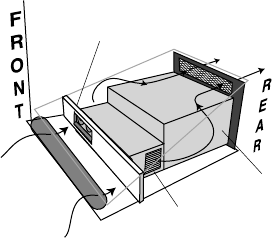
6
The PSW-2 performs within its acoustical specifications
and operates at a normal temperature if the TPL LED is
on for no longer than two seconds, and off for at least
one second. If the LED remains on for longer than three
seconds, the PSW-2 is hard limiting with these negative
consequences:
• Increasing the input level will not increase the
volume.
• The system distorts due to clipping and nonlinear
driver operation.
• The life-span of driver and amplifier components is
reduced because they are subjected to excessive
heat.
The TPL LED can indicate an imbalance in a system of
speakers by functioning like a spectrum analyzer. If
speakers in a subwoofer, mid-bass, or mid-hi subsystem
begin to limit before reaching the required operating
level for the entire system, then that subsystem needs to
be supplemented with additional speakers.
NOTE: Although the TPL limiters exhibit smooth sonic
characteristics, we do not recommend using them for
intentional compression effects. Use an outboard
compressor/limiter to compress a mixed signal.
Driver Excursion Clamp
The drivers in the PSW-2 are protected from over-
excursion by an excursion clamping circuit that does
not have attack or release time constants. The circuit
provides instantaneous braking for the drivers without
the pumping effects commonly produced by compressor/
limiters.
The circuit uses sophisticated filters to minimize the
distortion normally caused by clamping and clipping.
As the PSW-2’s input signal is increased past the
clamping point, the output signal remains at a fixed
level, protecting the drivers and minimizing negative
sonic effects. The PSW-2 operates safely if the Exc. Clamp
LED is on for no longer than two seconds, and off for at
least one second.
Fans and Cooling System
The PSW-2 uses a forced-air cooling system with two
fans to prevent the amplifiers from overheating. The
fans draw air in through ducts on the front of the cabinet,
over the heatsinks, and out the rear of the cabinet. Since
dust does not accumulate in the amplifier circuitry, its
life-span is increased significantly.
A foam insert filter, in combination with the entire front
grill surface, acts as an air filter for the cooling system.
Despite the filtering, extensive use or a dusty operating
environment can allow dust to accumulate along the
path of the airflow, preventing normal cooling. We
recommend periodically removing the grill, filter, and
amplifier module and using a vacuum cleaner to clear
dust from the grill, filter, fans, and heatsinks. Make sure
that the air ducts are clear and that there is at least six
inches clearance for exhaust behind the cabinet.
air
air
cooling
fans
heatsinks
power
supply
A variable-speed primary fan runs continuously with an
inaudible operating noise of 22 dBA at 1 m at its slowest
speed. The speed of the primary fan begins increasing
when the temperature of the heatsinks reaches 42°C.
The fan reaches full speed at 62°C and is barely audible
near the cabinet, even without an audio signal.
In the unusual event that the heatsink temperature reaches
74°C, the secondary fan turns on; it turns off when the
temperature decreases to 68°C. The secondary fan is
audible at close proximity without an audio signal and
turns on in response to
• primary fan failure (check its status immediately);
• accumulation of dust in the cooling system path;
• a prolonged period of high source levels in hot
temperatures or direct sunlight;
• driver failure.
TROUBLESHOOTING NOTE: In the highly unlikely event
that the secondary fan does not keep the temperature
below 85
°
C, the PSW-2 automatically shuts down until
AC power is removed and reapplied. If the PSW-2 shuts
down again after cooling and reapplying AC power,
contact Meyer Sound for repair information.



